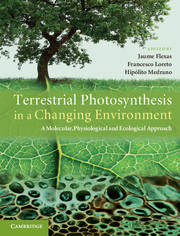 Terrestrial Photosynthesis in a Changing Environment
Terrestrial Photosynthesis in a Changing Environment Book contents
- Frontmatter
- Contents
- List of contributors
- Preface
- Acknowledgements
- List of abbreviations
- 1 Terrestrial photosynthesis in a changing environment
- Part I Photosynthesis
- 2 Biochemistry and photochemistry of terrestrial photosynthesis: a synopsis
- 3 Photosynthetic regulation
- 4 Interactions between photosynthesis and day respiration
- 5 The ecophysiology and global biology of C4 photosynthesis
- 6 Ecophysiology of CAM photosynthesis
- 7 Special photosynthetic adaptations
- 8 Models of photosynthesis
- Part II Measuring photosynthesis
- Part III Photosynthetic response to single environmental factors
- Part IV Photosynthesis in time
- Part V Photosynthesis in space
- Part VI Photosynthesis in a global context
- References
- Index
3 - Photosynthetic regulation
Published online by Cambridge University Press: 05 March 2013
- Frontmatter
- Contents
- List of contributors
- Preface
- Acknowledgements
- List of abbreviations
- 1 Terrestrial photosynthesis in a changing environment
- Part I Photosynthesis
- 2 Biochemistry and photochemistry of terrestrial photosynthesis: a synopsis
- 3 Photosynthetic regulation
- 4 Interactions between photosynthesis and day respiration
- 5 The ecophysiology and global biology of C4 photosynthesis
- 6 Ecophysiology of CAM photosynthesis
- 7 Special photosynthetic adaptations
- 8 Models of photosynthesis
- Part II Measuring photosynthesis
- Part III Photosynthetic response to single environmental factors
- Part IV Photosynthesis in time
- Part V Photosynthesis in space
- Part VI Photosynthesis in a global context
- References
- Index
Summary
Introduction
The evolution of oxygenic photosynthesis played an important role in the oxygenation of the atmosphere of the Earth. This rise in O2 also had an impact on the subsequent evolution of the photosynthetic organisms themselves, enabling them to develop more efficient bioenergetic systems. Thus, the reduction/oxidation (redox) reactions of the PET chain of green algae and higher plants and their regulation have become adapted to the O2-rich atmosphere of the Earth. Oxygen is, however, not only a product of photosynthesis but it is also a regulator of PET-chain activity and photosynthetic metabolism. Molecular O2 (3O2), is highly reactive and thus inherently toxic, but aerobic cells have evolved the ability to harness the energy potential of aerobic metabolism while minimising potentially harmful effects. Partly this is achieved by using the ROS, such as superoxide (O2–), hydrogen peroxide (H2O2) and singlet oxygen (1O2), formed as by-products of photosynthesis as important metabolic signals. The complex interactions of molecular O2 with the cellular electron-transport and metabolic systems of the cell have become an intrinsic feature of plant redox regulation and homeostasis.
Coordination between energy producing and energy utilising processes is at the heart of the processes that regulate photosynthesis and ensure efficient functioning over a wide range of environmental conditions. Respiration works alongside photosynthesis to secure efficient biological energy production in plant cells. However, unlike the regulation of respiration, which is driven by metabolic substrates that are protected from depletion by effective control mechanisms, the driving force for photosynthesis is the free energy of light, a substrate that cannot be conserved except through light harvesting, efficient charge separation and electron transport. The efficiency of the conversion of the free energy of light into chemical free energy by photosynthesis has been optimised during evolution. A complex network of defence systems protects photosynthesis against the potentially harmful effects of excess light, i.e., light capture that is in excess of the amount that can be used to drive photosynthesis. Efficient dissipation mechanisms are available to protect the photosynthetic membranes and their protein and pigment components by releasing the energy absorbed from light, largely as heat. Photosynthesis is thus able to operate in a highly flexible manner, harvesting energy efficiently at low irradiances and dissipating excess energy at high irradiance.
- Type
- Chapter
- Information
- Terrestrial Photosynthesis in a Changing EnvironmentA Molecular, Physiological, and Ecological Approach, pp. 20 - 40Publisher: Cambridge University PressPrint publication year: 2012
- 1
- Cited by
